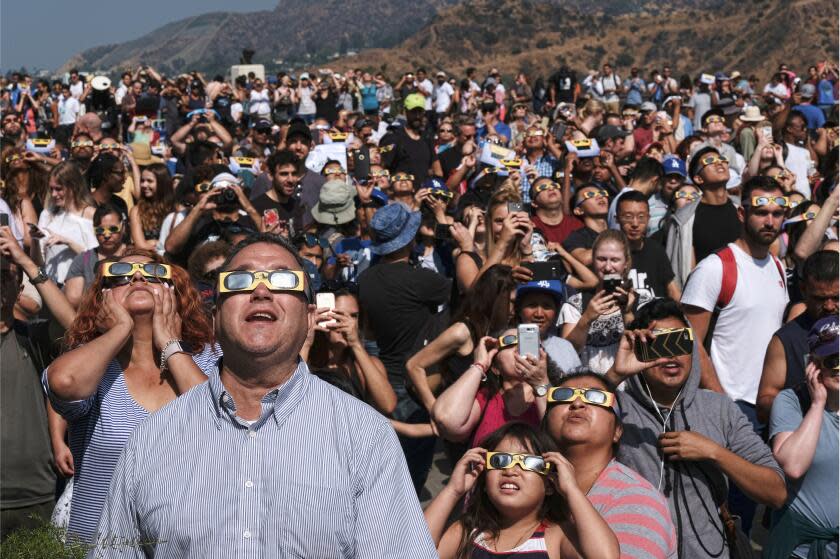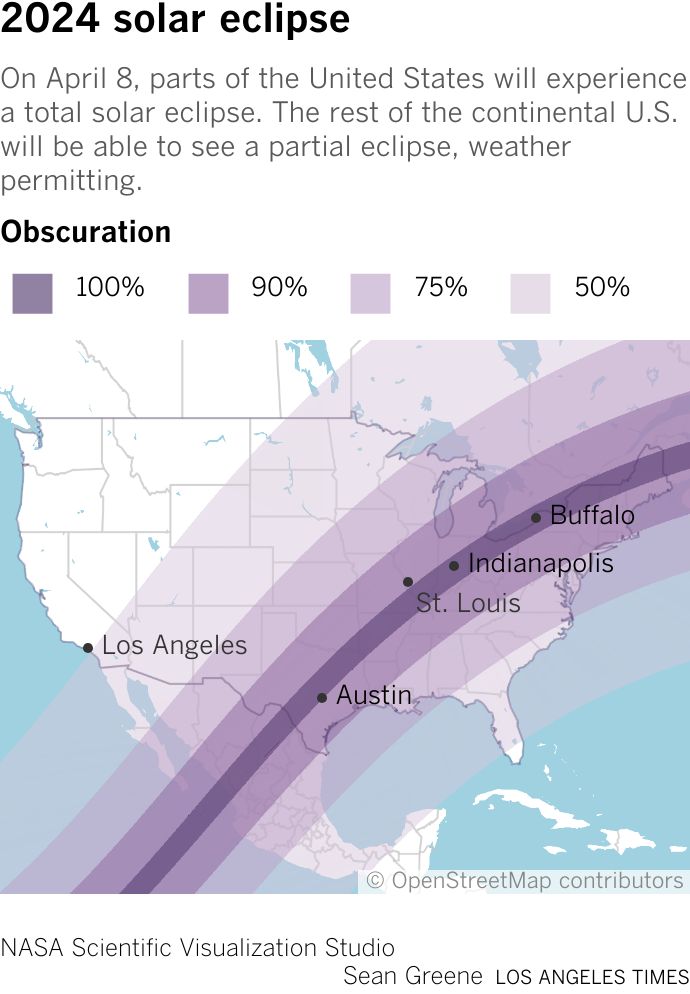Your last-minute guide to enjoying the solar eclipse — in L.A. and beyond

It's finally here: the great eclipse of 2024.
The last total solar eclipse that crossed the contiguous United States was in August 2017, according to NASA. Another one won’t cross again for 20 years.
Throngs of people are traveling to the Midwest and east, where the eclipse action will be the most dramatic.
And although California won’t experience the phenomenon of totality, there is still plenty to see.
Here is a quick guide:

What is a total solar eclipse?
Total eclipse: Midday darkness will be cast on a sliver of states, including Texas, Illinois, Ohio and New York — but there won’t be any “totality” in Los Angeles.
Partial eclipse: In Los Angeles, about half of the sun will be visibly covered by the moon, and in San Francisco, one-third will be. The northernmost parts of the state will see the smallest amount of the eclipse, while cities to the south will experience more.
Read more: How to watch the solar eclipse from California — and avoid heartbreak if chasing 'totality'
Read more: Solar eclipse thrills crowds in California as it darkens swath of countryside
Read more: A total eclipse is more than a spectacle. So I'm on the road to see it — again
What time is the eclipse?
In Los Angeles, a substantial blocking of the sun will be obvious by 10:39 a.m. and will peak at 11:12 a.m. By 12:22 p.m., it will be over, according to the Griffith Observatory.
There will be a lot of events locally.
Read more: 6 excellent L.A. spots to watch the awe-inspiring solar eclipse
How to see the eclipse
Looking up: The first rule of a solar eclipse is, don’t look at the sun without specialized eclipse glasses or a solar viewer. It’s not safe. If you look up at the eclipse without protection, it will cause severe eye injury, according to NASA.
Using the right glasses: Here are some safety and glasses tips. When you do get a pair of glasses or viewers, make sure they’re in good condition. If the viewers are torn, scratched or punctured, discard them. If the filters are coming loose from their cardboard or plastic frames, discard them.
Taking pictures: Even taking photos on your phone can pose risks to your eyes. Casually including the sun in a photo for a quick snapshot isn’t really a safety issue for the camera. But experts have tips.
Read more: Preparing for Monday's solar eclipse: What you need to do to watch safely
Read more: How to take a photo of the eclipse without damaging your phone
And finally ...
Enjoy the day! Rare moments can bring people together. At least some scientists think so.
Of course they can also spark end-times conspiracies (please, ignore those!).
At least it will be clear in Southern California. Elsewhere, cloudy skies risk spoiling the view for eclipse chasers. There are only expected to be a few small clouds in the Los Angeles area near the eastern San Gabriel Mountains, but even hikers on those peaks will still be able to catch the eclipse, according to National Weather Service meteorologist Kristan Lund.
Read more: How do animals react during a total solar eclipse? Scientists plan to find out in April
Read more: These scientists think an 'awe'-some eclipse could help unite Americans in troubled times
Read more: Going to miss the solar eclipse? Don’t worry, the next one is only years away
This story originally appeared in Los Angeles Times.

